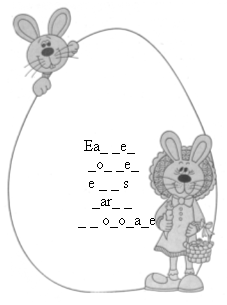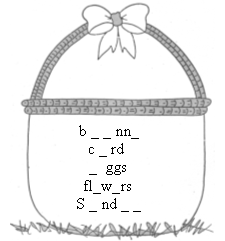- Преподавателю
- Иностранные языки
- Разработка внеклассного мероприятия, посвящённого пасхальным традициям англоговорящих стран (презентация = методичекое сопровождение) для 7-11кл. Можно использовать также и на уроках
Разработка внеклассного мероприятия, посвящённого пасхальным традициям англоговорящих стран (презентация = методичекое сопровождение) для 7-11кл. Можно использовать также и на уроках
| Раздел | Иностранные языки |
| Класс | - |
| Тип | Презентации |
| Автор | Чуварина Л.Г. |
| Дата | 03.07.2015 |
| Формат | rar |
| Изображения | Есть |
EASTER
Цели и задачи:
-
формирование положительной мотивации учения, готовности толерантно воспринимать культуру стран изучаемого языка и всего мира;
-
развитие лингвистических, творческих и артистических способностей учащихся;
-
знакомство с историей, традициями и символами праздника Пасхи в мире;
-
воспитание уважительного отношения к культурным ценностям народов мира.
-
расширение лексического запаса;
-
формирование фонетических навыков.
Инструментарий:
-
компьютер
-
проектор, экран
-
презентация в программе Power Point 2003
-
дидактический материал (карточки с текстами)
Teacher: Which holiday shall we celebrate tomorrow? (Слайд №1)
Работа со стихотворением (Слайд №2)
Through the sunshine
Through the shadow
Down the hills
Down the meadows
Little streams
Run bright and merry
Bursting with the news, they carry
Singing, shouting, laughing, humming,
Easter is coming!
Easter is coming!
Teacher: What Easter symbols do you know? (Слайд №3-4)
Do you know why rabbits became Easter symbols? (Работа с текстом на розданных до урока листочках).
Long ago in Germany there lived an old loving woman who liked children. Each year she gave them gifts to celebrate spring. One year she had nothing to give because it was a bad year and she had become very poor. All she had were some eggs. She didn't want to disappoint the children, so quickly before they arrived for their gifts, she coloured the eggs and hid them in the grass.
When the children arrived, she told them to run out into the lawn to find their gifts hiding there. Of course the children ran into the yard in search their surprises. Just as one of the children uncovered the eggs, a large rabbit hopped away. So the children thought that the rabbit had left the eggs for them. And ever since children have searched for the eggs left by the Easter rabbit on Easter morning. It is called the Easter Egg Hunt.
It is also true that in ancient Egypt the rabbit symbolized the moon. It also symbolized new life and birth. Because Easter's date is determined by the moon and Easter occurs in the spring time, it was natural that the rabbit continued to be one of the Easter symbols
Работа со стихотворением (Слайд №5)
Teacher: Look at the screen and make up sentences about some of Easter superstitions. (Слайд №6)
1. of, life, eggs, the, symbol, new, are. -Eggs are symbol of new life.
2. people, thought, long, that, ago, was, the, hatched, egg, a, gigantic, Earth, from. - Long ago people thought that the Earth was hatched from a gigantic egg.
3. On Easter Sunday, people believe, have luck, that, during the year, they can, in some countries, wearing three new things. - In some countries people believe that they can have good luck during the year wearing three new things on Easter Sunday.
Teacher: Let's read the text about Easter traditions around the world (на листочках).
Easter around the world
Easter in South America
The Holy week is the most important Catholic religious festival in South America. It begins on Palm Sunday and culminates on Easter Sunday.
Each day has its rituals processions through the streets with participants on their knees or carrying large wooden crosses.
On Palm Sunday palm leaves are blessed in the churches and people place the palm branches they have brought home behind their doors. They believe this assures the household of good luck and peace throughout the coming year. Churches are decorated with fruit and green plants.
After church people go into a wild celebrations with whistles church bells and fireworks. In many places people play rough (rude) games with a straw figure dressed as Judas, who told Roman soldiers where to catch Jesus. The Judas is hanged or burned by the crowd.
Easter in Germany
Easter in Germany is at the end of March or at the beginning of April.
On Easter Sunday families have nice breakfast together. Parents hide Easter baskets with sweets, eggs and small presents and say: "The Easter Bunny has hidden the Easter basket. Now you have to find it" and the children look for basket in the garden or in their houses. Pupils have about three week holidays at Easter. No one work on Good Friday, Easter Saturday and Easter Sunday.
Eggs are an important part of German Easter customs. Today it is not just the children who receive eggs, but adults often exchange beautifully hand painted eggs. There often accompanied with special message.
Easter in Australia
The main day of celebration of families is Easter Sunday. Some people go to the church and have hot sweet fruit buns which have a cross on their tops. Children exchange Easter eggs which are usually made of chocolate. Some are now made from sugar and have little toys inside.
Many families have Easter hunt in their homes or gardens to see who can find most eggs on Easter Sunday morning. Then they share a meal with their relatives. Traditionally they have roast lamb, beef or chicken with roasted vegetables like potatoes, carrot, pumpkin and beans, peas or broccoli. The Pavlova is the most popular desserts at family celebration in Australia. It is made of eggs whites and sugar.
Easter is the time when a lot of Australian families go on holidays as it is late summer or early autumn. Some go to the beach others to the mountains.
Easter in Spain
On Palm Sunday people go to mass in the morning, children carry palm leaves to be blessed. Boys carry a simple palm and girls carry a decorated branch with sweets, tinsel or other things.
Every night through the Easter week specially chosen people carry he statues of saints through the streets on wooden platforms.
There are few special Easter foods such as an Easter cake, traditional Easter sweets and variation known in England as "Eggy Bread".
Easter in Italy
On Easter Sunday people take palm and olive branches to the church to be blessed. The palms are often spread over fields for good luck or for patching up quarrels as an expression of peace.
Работа по прочитанному тексту "Easter Around the World" (Cлайды №7-9):
I. Ask questions beginning with the words in brackets
The Holy Week of Easter begins on Palm Sunday. (When…?)
-
Churches in South America are decorated on Easter with fruit and green plants. (What…with?)
-
People in South America play rough games with a straw figure dressed up as Judos. (What kind of …?)
-
Adults in Germany often exchange beautifully hand painted eggs like children. (Do..?)
-
On Palm Sunday people take palm branches to church to be blessed. (Why…?)
II. Are the following sentences true (T) or false (F)?
-
American people place the palm branches they brought home from church behind their stove doors.
-
A straw figure of Judos is burned by Australians.
-
Pupils in Germany have a week holiday at Easter.
-
Traditionally many families in Australia eat roast turkey at Easter.
-
Australians celebrate Easter in spring.
-
"Eggy bread" is traditional Easter food in Spain and Italy.
III. Choose the right answer based on the information from the text:
1. American people place the palm branches they brought home from church behind their doors because:
-
they believe it'll bring good luck and peace
-
They think it'll help to become rich
-
They want to decorate their
2. Many families have an Easter hunt in their homes or gardens:
a) because they enjoy hunting
b) to see who can find the most eggs on Easter Sunday morning.
3. In Italy people often spread the palms over fields
a) to be healthy
b) to be happy all day long
c) for avoiding quarrels
Teacher: At the end of our lesson I would like to read Easter wishes for you (Cлайд № 12)
Because
You're very special,
This wish is just for you-
Have a very happy Easter
And a springtime, too.
Эта разработка предназначена для обучающихся 9-11 классов. Её можно использовать также в 5-7 классах, убрав работу с текстом "Easter Around the World". Вместо него взять следующие задания:
Guess the words :
1)
P
A
E
Y
L
L
E
J
M
P
M
E
A
S
T
E
Y
T
S
A
S
K
E
T
S
G
I
J
E
G
G
S
A
H
N
Y
T
U
N
E
K
O
E
D
I
X
C
U
N
N
Y
I
N
O
T
P
S
U
N
D
A
Y
A
A
C
H
O
C
O
L
A
T
E
O
S
P
I
N
G
Y
X
E
S
E
P
A
E
I
D
Y
E
2)

3)

6


